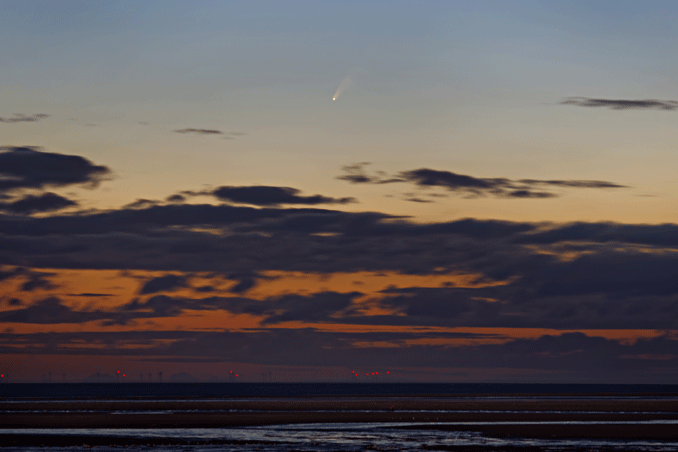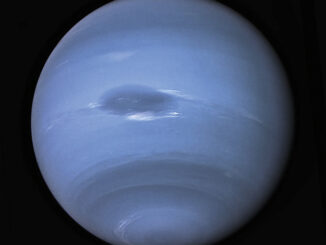Updated: 10 July 2020.

Comet 2020 F3 (NEOWISE) is putting on a fine showing in the pre-dawn northern sky after emerging intact from perihelion (closest point to the Sun), which occurred on 3 July when the comet passed 0.29 astronomical unit, or 43 million kilometres from the Sun. It was discovered by NASA’s Near Earth Object Wide-field Infrared Survey Explorer (NEOWISE) spacecraft on March 27. By the start of next week it becomes better placed in the evening sky, while remaining visible in the pre-dawn sky.
The flood of images taken post-perihelion show a healthy-looking comet punching through the strong twilit sky and sporting a marvellous fan-shaped tail. Its main dust tail extends to around six degrees in length as seen in the best images and its also sprouted a fainter, bluish ion tail. Presently shining around magnitude +1 to +2, reports have it as a reasonably easy object to spot with the naked eye in a haze-free pre-dawn sky.
The comet has sprung somewhat of another surprise in that it has a very large nucleus. Researchers working with NASA’s NEOWISE spacecraft have analysed infra-red emissions of the comet’s core, taken from the spacecraft, and by combining this with visible-light images has revealed that the nucleus is about five kilometres (three miles) across and covered with sooty, dark particles left over from its formation near the time of the origins of our Solar System some 4.6 billion years ago. Its size was a big factor in its survival from its fiery passage around the Sun at perihelion.Comet 2020 F3 (NEOWISE) is circumpolar (never-setting) across the length and breadth of UK. It’s visible for a while shortly after sunset too, but over this weekend your best chance of seeing or imaging it is to have to get up early to catch it in the pre-dawn sky. You’ll need to find an outlook with an unobstructed horizon from due north around to the north-east (the comet’s azimuth is between about 27 and 32 degrees).

On the morning of 11 July by the beginning of nautical twilight (when the Sun lies between 12 and 6 degrees below the horizon), which occurs at around 2.45am and 3am BST (01:45 and 02:00 UT) from Manchester and London (in Scotland, nautical twilight persists throughout the night), respectively, NEOWISE lies about nine degrees above the north-north-eastern horizon. It’s located among the stars of Auriga, just over eight degrees east-south-east of magnitude +1.9 Menkalinan (beta) Aurigae. Brilliant Capella, lying at just under 20 degrees altitude is a good guide for locating the comet. Look to Capella’s left (east) to find Menkalinan, and then by roughly the same distance again in the same direction to find the comet. Try sweeping with a pair of binoculars to find it and then see if you can see it without optical aid.

Comet NEOWISE is circumpolar (never-setting) across the length and breadth of UK. It’s visible for a while shortly after sunset too, but over this weekend your best chance of seeing or imaging it is to have to get up early to catch it in the pre-dawn sky. You’ll need to find an outlook with an unobstructed horizon from due north around to the north-east (the comet’s azimuth is between about 27 and 32 degrees).
As the month progresses, the comet improves in visibility across the UK, increasing in elevation as it moves north-eastwards through Auriga. Hopefully, it will hold steady in brightness, but there’s no knowing exactly how it will behave as it pulls away from the Sun. NEOWISE then becomes better placed in the early-evening sky; by Monday 13 July at the end of civil twilight, it sits about 15 degrees above the north-north-west horizon (at an azimuth of between 332 and 340 degrees). It’s still on show in the pre-dawn sky.

By mid-month, comet NEOWISE has moved into neighbouring Lynx and will have improved significantly in early-evening visibility, lying not far short of 20 degrees altitude in the north-north-western sky at the end of civil twilight (at about 10pm, 10.20pm and 10.40pm BST (21:00, 21:20 and 21:40 UT) from London, Manchester and Edinburgh, respectively. The comet has picked up speed in its motion across the sky as it heads towards closest approach to Earth, which occurs on 23 July when NEOWISE passes us at a distance of 0.69 astronomical unit or 103 million kilometres.
Although cometNEOWISE can’t be ranked along the great comets of the past (yet…!), such as Hale-Bopp or 2006 P1 (McNaught), it’s one to enjoy as the first naked-eye comet of 2020 and an anecdote to the earlier naked-eye disappointments of comets 2019 Y4 (ATLAS) and 2020 F8 (SWAN).





